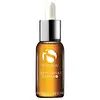What's inside
What's inside
 Key Ingredients
Key Ingredients

 Benefits
Benefits

 Concerns
Concerns

 Ingredients Side-by-side
Ingredients Side-by-side

Water
Skin ConditioningButylene Glycol
HumectantCaprylic/Capric Triglyceride
MaskingIsosorbide Dicaprylate
Skin ConditioningGlyceryl Stearate
EmollientGlycerin
HumectantPropanediol
SolventSodium Acrylates Copolymer
Chlorogenic Acids
AntioxidantHydrolyzed Sodium Hyaluronate
Skin ConditioningGlycyrrhiza Glabra Root Extract
BleachingAminopropyl Ascorbyl Phosphate
AntioxidantErgothioneine
AntioxidantEctoin
Skin ConditioningHydroxyectoin
BufferingCassia Alata Leaf Extract
AstringentCarnosine
Skin ConditioningCamellia Sinensis Leaf Extract
AntimicrobialVitis Vinifera Seed Extract
AntimicrobialTheobroma Cacao Seed Extract
AntioxidantCurcuma Longa Root Extract
MaskingOlea Europaea Fruit Extract
BleachingEuterpe Oleracea Fruit Extract
Nelumbo Nucifera Flower Extract
Skin ConditioningNymphaea Caerulea Flower Extract
Skin ConditioningBuddleja Officinalis Flower Extract
UV FilterCoffea Arabica Leaf Cell Extract
AntioxidantCrocus Sativus Leaf Cell Culture Extract
Skin ProtectingOpuntia Ficus-Indica Stem Extract
Skin ConditioningSuperoxide Dismutase
AntioxidantUbiquinone
AntioxidantZingiber Officinale Root Extract
MaskingCeramide NP
Skin ConditioningCeramide AP
Skin ConditioningCeramide EOP
Skin ConditioningLinoleic Acid
CleansingLinolenic Acid
CleansingSalicylic Acid
MaskingBisabolol
MaskingTocopherol
AntioxidantTocopheryl Acetate
AntioxidantCholesterol
EmollientPhytosphingosine
Skin ConditioningSodium PCA
HumectantLecithin
EmollientXanthan Gum
EmulsifyingSclerotium Gum
Emulsion StabilisingPullulan
Ammonium Polyacryloyldimethyl Taurate
Emulsion StabilisingPentaerythrityl Tetra-Di-T-Butyl Hydroxyhydrocinnamate
AntioxidantSodium Stearoyl Glutamate
CleansingSodium Lauroyl Lactylate
EmulsifyingPhytic Acid
Maltodextrin
AbsorbentCarbomer
Emulsion StabilisingSilica
AbrasiveSodium Hydroxide
BufferingCitric Acid
BufferingEthylhexylglycerin
Skin ConditioningPhenoxyethanol
PreservativeWater, Butylene Glycol, Caprylic/Capric Triglyceride, Isosorbide Dicaprylate, Glyceryl Stearate, Glycerin, Propanediol, Sodium Acrylates Copolymer, Chlorogenic Acids, Hydrolyzed Sodium Hyaluronate, Glycyrrhiza Glabra Root Extract, Aminopropyl Ascorbyl Phosphate, Ergothioneine, Ectoin, Hydroxyectoin, Cassia Alata Leaf Extract, Carnosine, Camellia Sinensis Leaf Extract, Vitis Vinifera Seed Extract, Theobroma Cacao Seed Extract, Curcuma Longa Root Extract, Olea Europaea Fruit Extract, Euterpe Oleracea Fruit Extract, Nelumbo Nucifera Flower Extract, Nymphaea Caerulea Flower Extract, Buddleja Officinalis Flower Extract, Coffea Arabica Leaf Cell Extract, Crocus Sativus Leaf Cell Culture Extract, Opuntia Ficus-Indica Stem Extract, Superoxide Dismutase, Ubiquinone, Zingiber Officinale Root Extract, Ceramide NP, Ceramide AP, Ceramide EOP, Linoleic Acid, Linolenic Acid, Salicylic Acid, Bisabolol, Tocopherol, Tocopheryl Acetate, Cholesterol, Phytosphingosine, Sodium PCA, Lecithin, Xanthan Gum, Sclerotium Gum, Pullulan, Ammonium Polyacryloyldimethyl Taurate, Pentaerythrityl Tetra-Di-T-Butyl Hydroxyhydrocinnamate, Sodium Stearoyl Glutamate, Sodium Lauroyl Lactylate, Phytic Acid, Maltodextrin, Carbomer, Silica, Sodium Hydroxide, Citric Acid, Ethylhexylglycerin, Phenoxyethanol
 Reviews
Reviews

Alternatives
Ingredients Explained
These ingredients are found in both products.
Ingredients higher up in an ingredient list are typically present in a larger amount.
Glycerin is already naturally found in your skin. It helps moisturize and protect your skin.
A study from 2016 found glycerin to be more effective as a humectant than AHAs and hyaluronic acid.
As a humectant, it helps the skin stay hydrated by pulling moisture to your skin. The low molecular weight of glycerin allows it to pull moisture into the deeper layers of your skin.
Hydrated skin improves your skin barrier; Your skin barrier helps protect against irritants and bacteria.
Glycerin has also been found to have antimicrobial and antiviral properties. Due to these properties, glycerin is often used in wound and burn treatments.
In cosmetics, glycerin is usually derived from plants such as soybean or palm. However, it can also be sourced from animals, such as tallow or animal fat.
This ingredient is organic, colorless, odorless, and non-toxic.
Glycerin is the name for this ingredient in American English. British English uses Glycerol/Glycerine.
Learn more about GlycerinPhenoxyethanol is a preservative that has germicide, antimicrobial, and aromatic properties. Studies show that phenoxyethanol can prevent microbial growth. By itself, it has a scent that is similar to that of a rose.
It's often used in formulations along with Caprylyl Glycol to preserve the shelf life of products.
Water. It's the most common cosmetic ingredient of all. You'll usually see it at the top of ingredient lists, meaning that it makes up the largest part of the product.
So why is it so popular? Water most often acts as a solvent - this means that it helps dissolve other ingredients into the formulation.
You'll also recognize water as that liquid we all need to stay alive. If you see this, drink a glass of water. Stay hydrated!
Learn more about Water